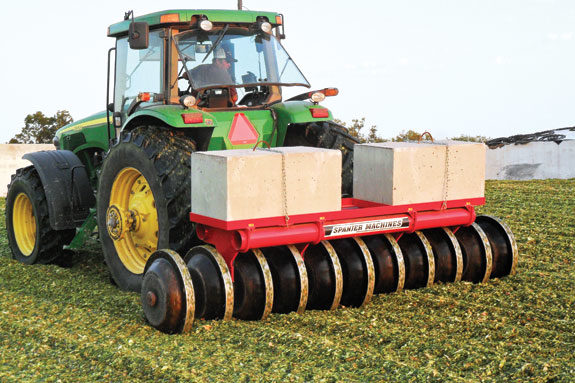Several dairy producers in the Midwest recently saw an opportunity to improve their feed storage capacity and feed quality with a new pull-behind tractor implement. The Impact Silage Packer follows a very simple concept – using weight to pack down feed. The packer is basically an implement consisting of rollers that each weigh 650 pounds and are designed to increase feed compaction on forage piles and bunkers.
Spanjer Machines based out of Ontario, Canada, came up with the design for the packer in 2008. Laurence Martin, also from Ontario, works for an independent company that builds the machines for Spanjer.
“The idea came up and the machine was tried out on a few different farms,” Martin says. “We started using the product on a trial basis and then grew from there.”
Importance of compaction
Jon Rasmussen, dairy technology specialist at Vita Plus in Wisconsin, explains that good compaction results in an increase in packing density and provides benefits that are multifold.
“The primary benefit is that the producer decreases the amount of dry matter loss,” Rasmussen says. “Other benefits include better forage fermentation, which helps keep a more stable product all the way through.”
When fresh forages are moved from the field to the storage location, the forage is aerated, enabling oxygen to filter through the feed.
Removing this air is important to allow for a faster fermentation, which helps preserve the crop and maintain its quality.
If the feed is not compacted and the air is left in a covered pile, the remaining oxygen fosters microbial growth, resulting in feed spoilage.
Product designers say the new implement helps remove air from the ensiled forages by packing the feed tightly, thoroughly and effectively.
Rasmussen points out that the amount of space required for the forage crop is also reduced due to the compaction. “With a good density, you can increase the amount of feed in a storage unit and not necessarily have to use more space,” he says.
Dick Van Rijn, a dairy producer from Deford, Michigan, bought his packer halfway through his crop harvest two years ago in order to help improve the compaction of his silage pile.
“We had a pretty good density before, but I was trying to do better,” Van Rijn says. “What I see now is that the pile looks much nicer than when you just push up the silage, because it levels it off too.”
He explains that after packing for a while he found it better to lift the implement up during the first few runs and only pack the silage down with the tractor tires because the silage was loose.
Afterward, he would lower the implement and use it to finish compacting the silage.
He also points out that he had to place additional weight on the front of the tractor to counter the weight of the implement behind the tractor.
Packing densities
Rasmussen works with producers that use the new packing implement to obtain density tests from ensiled forages such as haylage or corn silage and are expressed in pounds of dry matter per cubic foot.
Rasmussen looks for 20 pounds of dry matter per cubic foot of the ensiled forage. He explains that a higher density is usually obtained with haylage, whereas the packing density for corn silage is usually a little lighter.
“If you are aiming for 20 and you’re at 18 on corn silage, that’s probably acceptable,” Rasmussen says. “If you’re at 18 on haylage, you might question that amount.”
Rasmussen performs forage benchmarks every year for his customers, looking at a number of items including packing densities.
As far as results go, Rasmussen says he has seen producers with good numbers that resulted from using the implement and others that could have used a little more time or a little more weight on the pile to improve their numbers.
“It comes down to pounds per square inch that a producer can put on their feed,” he says. “The densities are what improve feed quality – getting enough weight on the feed coming into the pile or bunker is the utmost important part.”
Finding a system for you
The manner in which the producer uses the packing implement, as well as how and where the forage is packed, how fast the crop is delivered and the number of times the producer goes over forage also plays a role in how the packer will work for each individual producer.
John Ruedinger, a dairy producer from Van Dyne, Wisconsin, bought his packing implement in the spring of 2011. He currently grows all of his forages and purchases all grains.
When packing his haylage last year, Ruedinger noticed that the forage tended to bunch up between the implement’s rollers because it was so loose.
Like Van Rijn, Ruedinger began packing the haylage with the tractor tires on the first run and then dropped the implement on the second run to help firm up the haylage.
“When you are driving back and forth on your pile packing from one side to the other, you are able to pack more square feet at the same time because the rollers are spread across the packer,” he says. “This is beneficial in getting good compacted layers throughout the whole pile.”
Ruedinger recently finished feeding his corn silage from the 2010 harvest and plans to take density tests on the 2011 crop within the next few months to compare last year’s forage packing densities to those from previous years.
“I’m hoping I’ll see a difference on the side slopes after using the packer,” Ruedinger says. “The side slopes are a challenge because you don’t have as much weight on top as you do in the center of the pile to help pack it down.”
Dave Sleik, another Wisconsin producer, learned about the new implement after seeing another producer use it to pack corn silage. He saw that the producer was doing a good job packing the silage, so he contacted Spanjer and had one imported.
“We were also hoping we could cut down on the number of tractors we had packing,” Sleik says. “Right now we push the silage with one tractor and pack with another.”
Sleik has now had the packing implement for two full growing seasons. He mentions that it is part of a forage management system and will not work on its own. In terms of packing densities, he says he is getting more dry matter in a smaller amount of space.
“This is really easy for us to see because we weigh everything going in,” he says. “If you look at our piles, they are physically smaller with the same amount of feed in them.”
Size for every operation
The packer is available in multiple sizes to accommodate different operation sizes. The smallest model has five rollers and is used mostly with smaller tractors and in smaller operations that pack silage in smaller bunkers.
Each subsequent model increases by two rollers until you reach the largest model, which has 13 rollers. The five-roller model is six feet wide and weighs 3,300 pounds, whereas the 13-roller model is 16 feet wide and has a weight of 8,450 pounds.
Jeff Liner, sales and marketing manager at Agromatic , which distributes the implement in the U.S., says the model that has initially sold the most, is the nine-roller, which also costs approximately $10,500.
Additionally, the top of each packer is designed with brackets that can accommodate cement blocks weighing 2,500 pounds to increase the total weight of the implement and the total compaction rate. PD
For more information about this new technology, contact Jeff Liner at jliner@agromatic.net or (920) 922-1970 .
YOUR RESULTS
Would you benefit from this type of forage packer? The following checklist can be used to determine if this new technology might be a fit for your operation.
1. Have you considered other options to pack silage in tighter?
2. Are you concerned about the quality of your silage?
3. Do you have high feed loss on your operation?
4. Are you concerned with leaving too much oxygen in your feed?
5. Have you noticed inconsistencies in your silage pile or bunker?
6. Are you looking to increase the compaction of your forages?
7. Do you want to maximize the amount of space you have to store your forages?
If you answered yes to five or more of these questions, this technology may be one for you to consider.

Dario Martinez
Assistant Editor
dario@progressivedairy.com






